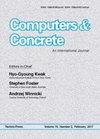Effect of pumice powder and artificial lightweight fine aggregate on self-compacting mortar
IF 3.3
4区 工程技术
Q2 COMPUTER SCIENCE, INTERDISCIPLINARY APPLICATIONS
引用次数: 7
Abstract
An experimental program was conducted to investigate the fresh properties, mechanical properties and durability characteristics of the self-compacting mortars (SCM) produced with pumice powder and Artificial Lightweight Fine Aggregate (aLWFA). aLWFA was produced by using fly ash. A total of 16 different mixtures were designed with a constant water-binder ratio of 0.37, in which natural sands were partially replaced with aLWFA and pumice powder at different volume fractions of 5%, 10% and 15%. The artificial lightweight aggregates used in this study were manufactured through cold bonding pelletisation of 90% of class-F fly ash and 10% of Portland cement in a tilted pan with an ambient temperature and moisture content. Flowability tests were conducted on the fresh mortar mixtures beforehand, to determine the self-compacting characteristics on the basis of EFNARC. To determine the conformity of the fresh mortar characteristics with the standards, mini-slump and mini-V-funnel tests were carried out. Hardened state tests were conducted after 7, 28 and 56 days to determine the flexural strength and axial compressive strength respectively. Durability, sorptivity, permeability and density tests were conducted at the end of 28 days of curing time. The test results showed that the pumice powder replacement improved both the fresh state and the hardened state characteristics of the mortar and the optimum mixture ratio was determined as 15%, considering other studies in the literature. In the aLWFA mixtures used, the mechanical and durability characteristics of the modified compositions were very close to the control mixture. It is concluded in this study that mixtures with pumice powder replacement eliminated the negative effects of the aLWFA in the mortars and made a positive contribution.浮石粉与人工轻质细骨料对自密实砂浆的影响
通过试验研究了以浮石粉和人工轻质细骨料配制的自密实砂浆(SCM)的新鲜性能、力学性能和耐久性。以粉煤灰为原料制备全氟化铝。在水胶比为0.37的恒定条件下,设计了16种不同的混合材料,其中aLWFA和浮石粉以5%、10%和15%的体积分数代替部分天然砂。本研究中使用的人造轻质骨料是在倾斜的平底锅中,在室温和湿度条件下,将90%的f类粉煤灰和10%的波特兰水泥冷粘合成球而制成的。在EFNARC的基础上,事先对新拌砂浆进行了流动性试验,以确定其自密实特性。为了确定新砂浆的性能是否符合标准,进行了小坍落度和小v型漏斗试验。分别在7天、28天和56天后进行硬化状态试验,测定试件的抗折强度和轴向抗压强度。在养护28天结束时进行耐久性、吸附性、渗透性和密度测试。试验结果表明,更换浮石粉改善了砂浆的新鲜状态和硬化状态特性,综合文献研究,确定最佳配比为15%。在使用的aLWFA混合物中,改性组合物的力学和耐久性特性与对照混合物非常接近。本研究认为,用浮石粉替代的混合物消除了砂浆中aLWFA的负面影响,做出了积极的贡献。
本文章由计算机程序翻译,如有差异,请以英文原文为准。
求助全文
约1分钟内获得全文
求助全文
来源期刊

Computers and Concrete
工程技术-材料科学:表征与测试
CiteScore
8.60
自引率
7.30%
发文量
0
审稿时长
13.5 months
期刊介绍:
Computers and Concrete is An International Journal that focuses on the computer applications in be considered suitable for publication in the journal.
The journal covers the topics related to computational mechanics of concrete and modeling of concrete structures including
plasticity
fracture mechanics
creep
thermo-mechanics
dynamic effects
reliability and safety concepts
automated design procedures
stochastic mechanics
performance under extreme conditions.
 求助内容:
求助内容: 应助结果提醒方式:
应助结果提醒方式:


